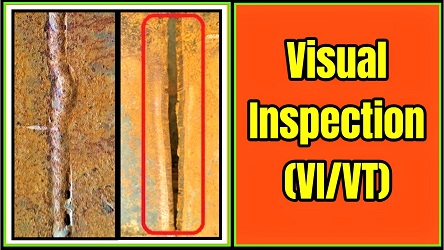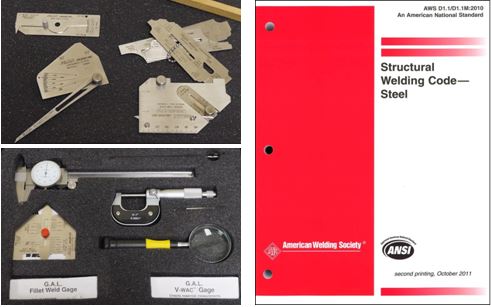Welding Inspection Racine: Making Certain Accuracy and Integrity in Every Weld
Wiki Article
Cutting-edge Methods to Fillet Weld Examination and Testing: Enhancing Weld Top Quality and Compliance Requirements
In the realm of welding, the quality and stability of fillet welds play an important duty in making certain the architectural soundness and reliability of various industrial components. With the constant drive for improved efficiency and compliance with strict criteria, the exploration of innovative approaches to fillet weld assessment and testing has ended up being critical.
Advanced Non-Destructive Testing Techniques
Using advanced modern technologies, progressed non-destructive screening techniques play a vital function in ensuring the integrity and quality of fillet welds. These methods, such as phased array ultrasonic screening (PAUT) and magnetic fragment screening (MPT), offer comprehensive insights into the weld's inner framework without triggering any type of damage to the material. PAUT, for instance, utilizes multiple ultrasonic aspects to check the weld from numerous angles, giving a comprehensive visualization of prospective issues like absence of fusion or splits.By employing these innovative non-destructive testing methods, weld inspectors can precisely assess the high quality of fillet welds, ensuring compliance with sector standards and laws. The ability to identify flaws early on not just boosts weld quality however additionally avoids costly rework or failings in architectural honesty, highlighting the relevance of these ingenious testing strategies in welding assessments.
Robotics and Automation in Inspection
The combination of robotics and automation has actually changed the inspection process for fillet welds, improving effectiveness and precision in top quality analysis. Robotics offer specific control and repeatability in inspecting welds, guaranteeing constant and trusted results. Automated systems can be programmed to follow specific inspection paths, ensuring comprehensive coverage of welds and decreasing the risk of human error.Robotic inspection systems equipped with innovative sensing units can identify and gauge weld attributes with high accuracy, supplying comprehensive data for analysis. These systems can recognize issues such as splits, absence of combination, and porosity, enabling prompt rehabilitative activities to be taken. Furthermore, robotics and automation enable real-time data collection and evaluation, supplying instant feedback to drivers and promoting fast decision-making processes.
In addition, the usage of robotics and automation in fillet weld evaluation improves general productivity by lowering assessment times and enhancing examination throughput. By improving the inspection procedure, producers can ensure weld high quality and compliance requirements are met successfully, ultimately bring about cost financial savings and enhanced product top quality.
Using Expert System for Analysis
Expert system plays an essential duty in improving the performance and accuracy of analysis in fillet weld inspection procedures. By utilizing the power of AI, examiners can streamline the analysis of weld top quality and compliance requirements, leading to much more exact and reliable outcomes. AI algorithms can quickly refine vast amounts of data from weld assessments, detecting problems or variances that might be testing to relate to the naked eye. This sophisticated innovation makes it possible for real-time surveillance of weld high quality, permitting prompt corrective activities to be taken if any type of concerns are spotted.Additionally, AI systems can find out from previous inspection information, consistently enhancing their capacity to determine possible issues and deviations in fillet welds. This adaptive understanding capacity improves the total quality assurance procedure, decreasing the probability of human error and guaranteeing that welds meet the required standards. By integrating man-made knowledge into fillet weld analysis, sectors can achieve greater degrees of efficiency, uniformity, and compliance in their inspection techniques.
Portable Devices for On-Site Evaluation
Enhancing area examination effectiveness, the adoption of mobile devices reinvents on-site evaluation processes for fillet welds. These devices supply flexibility and benefit, permitting examiners to perform extensive exams in numerous areas, consisting of tough or remote view it atmospheres. Mobile devices such as ultrasonic screening devices, magnetic particle evaluation tools, and electronic radiography systems give real-time information and high-resolution imaging abilities, enabling fast decision-making and immediate feedback on weld high quality.One significant benefit of portable tools is their capability to enhance examination treatments, look here reducing downtime and enhancing general productivity. Inspectors can easily transfer these tools to various job websites, getting rid of the demand for moving heavy equipment or elements to off-site centers. In addition, the portability of these tools promotes cost-effectiveness by reducing transportation expenditures and increasing examination timelines.
Furthermore, using portable tools for on-site assessment advertises aggressive quality control measures, as examiners can without delay recognize and address any type of potential welding problems or discrepancies. By incorporating these ingenious modern technologies right into on-site inspection practices, welding specialists can make sure compliance with industry requirements and boost weld top quality, inevitably causing enhanced architectural integrity and security in various welding applications.

Combination of Information Management Systems
Having optimized on-site examination processes through the usage of mobile tools, the next stage involves the seamless combination of data administration systems to even more boost performance and information evaluation capacities in fillet weld evaluation and screening. By incorporating data monitoring systems right into the evaluation process, organizations can streamline data collection, storage space, and analysis. This integration allows for real-time surveillance of weld top quality, prompt recognition of problems, and punctual decision-making to remedy any concerns that may arise during the examination process.Information monitoring systems play an essential role in systematizing examination data, helping with easy accessibility for licensed workers, and making certain information stability and safety. Via the combination of these systems, examiners can generate comprehensive records, track historic data for fad analysis, and boost overall process performance. Additionally, the combination of information management systems allows smooth interaction between different stakeholders associated with the inspection process, promoting cooperation and enhancing overall high quality control actions. Ultimately, the integration of data management systems serves to raise the criteria of fillet weld inspection and testing, guaranteeing compliance with market policies and improving weld high quality.
Conclusion
In conclusion, cutting-edge techniques to fillet weld assessment and testing have actually dramatically improved weld high quality and conformity requirements. Advanced non-destructive testing approaches, robotics, automation, fabricated intelligence, mobile devices, and data monitoring systems have actually transformed the means weld assessments are conducted. over at this website By making use of these innovations, industries can make certain that welds satisfy the required high quality standards and laws, eventually boosting general performance and security in welding procedures.By utilizing these advanced non-destructive screening techniques, weld examiners can properly evaluate the top quality of fillet welds, guaranteeing conformity with industry requirements and regulations - Welding Inspection Racine. Portable devices such as ultrasonic testing gadgets, magnetic fragment assessment tools, and digital radiography systems offer real-time information and high-resolution imaging capabilities, allowing fast decision-making and immediate comments on weld top quality
Having enhanced on-site assessment procedures through the use of mobile tools, the next stage entails the seamless integration of information monitoring systems to further improve effectiveness and information evaluation capabilities in fillet weld assessment and screening. Ultimately, the integration of data administration systems offers to boost the criteria of fillet weld inspection and testing, guaranteeing conformity with market laws and enhancing weld quality.
In verdict, ingenious methods to fillet weld assessment and screening have significantly improved weld quality and conformity requirements. (Welding Inspection Racine)
Report this wiki page